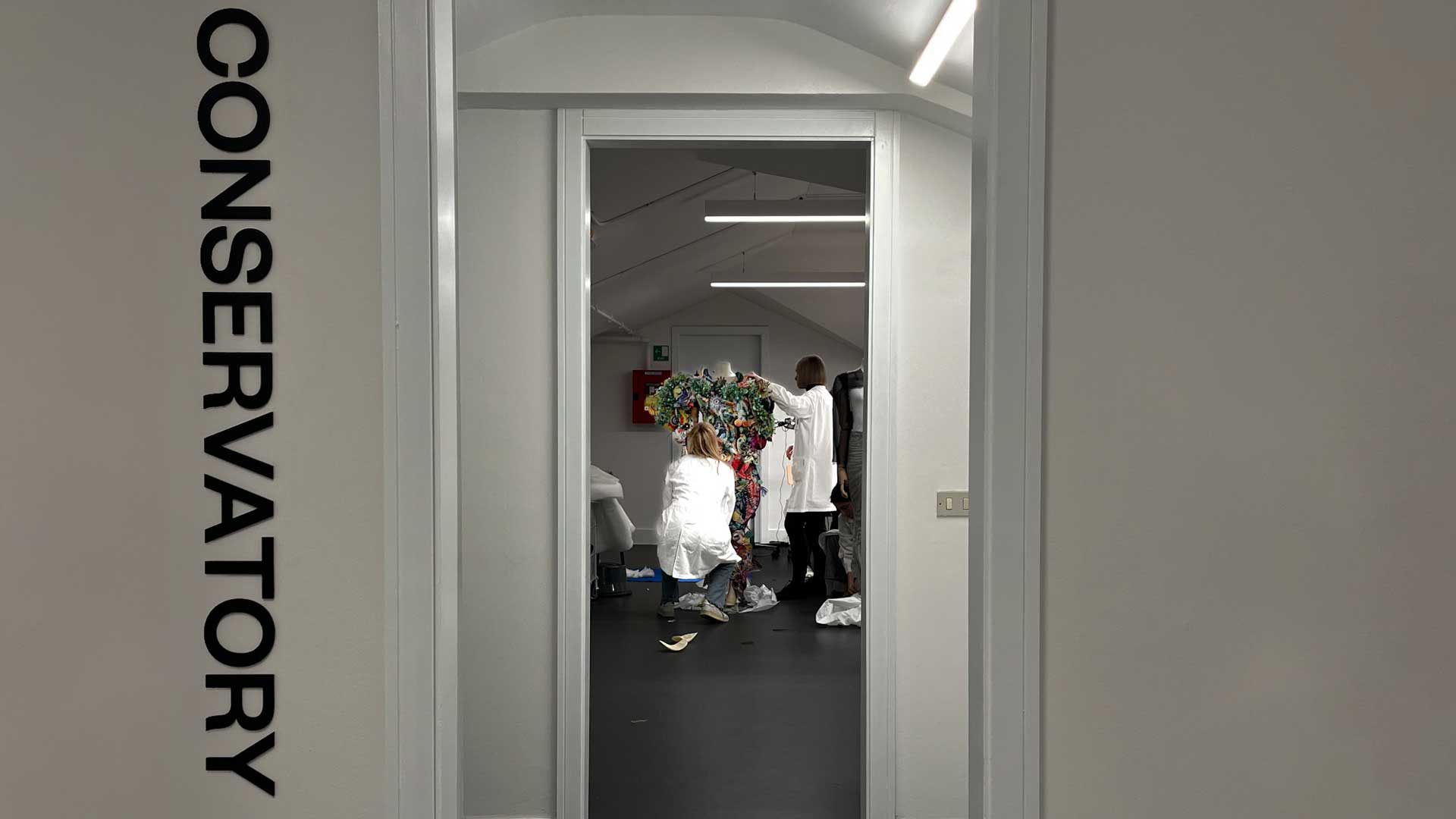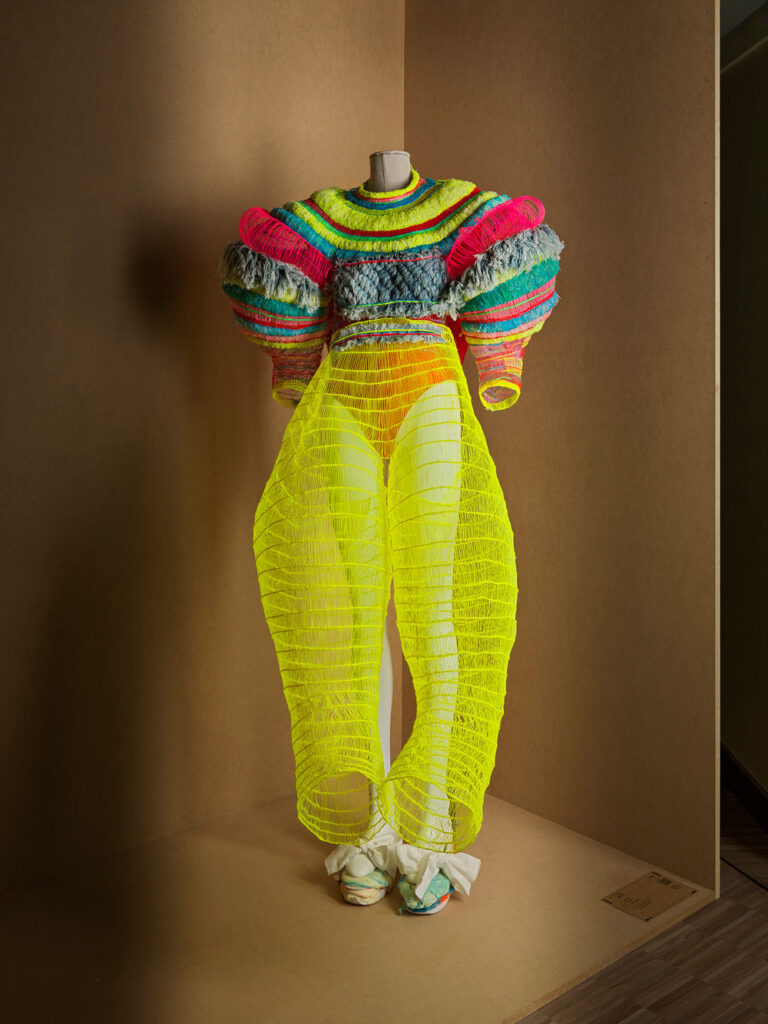
A Year in Fashion Conservation: Planned work for 2024 by the ITS Collection conservation team.
02 August 2024
We have already dealt with the huge (and beautifully exciting) work that is the conservation of a unique collection like the one of ITS Arcademy – Museum of Art in Fashion, you can read about it here. We sat down again with Virginia Dordei, Head of the Conservation team and responsible for the integrity of the entire ITS Collection, this time to talk about what are going to be the next items undergoing restoration in their agenda for 2024.
From actual canvas painting techniques to 3D doodle pen interventions, silicone decorations and containment of collapsing structures, a mix of creative thinking, technology and craftsmanship involves the actions of the team, to come up with solutions meant to preserve and extend the life of these unique creations.
“When we moved Richard Quinn’s outfit from our old location to ITS Arcademy, it went straight on the mannequin for ‘The First Exhibition: 20 Years of Contemporary Fashion Evolution’ bypassing the archival process of assessment, labelling and cataloguing. It was immediately showcased” told us Virginia Dordei, “and during the dismantling, due to this peculiarity, it remained on the mannequin from our first exhibition and was stored in a dedicated closet. We are now ready to approach its unique feature, since it’s made of a painter’s canvas, over which Richard Quinn (ITS Contest 2015 finalist) literally painted with acrylic colours, adding adornment details in glitter.”
This means that the team will have to carry out an in-depth study mixing painting restoration techniques with traditional ones. In addition, underneath the canvas lies a double internal structure providing the volumes of the garment: a kind of petticoat, with another petticoat underneath it made of a material similar to crinoline, but slightly stiffer. “The mannequin might not be the right place for it; we will probably need to create a special bodice for the skirt to rest on, since the weight could collapse the structure.” This art piece is literally a three dimensional painting on the body, which means conversation will most likely involve, in the future, dedicated specialists in painting conservation. In the meantime, a tailored external protective cover, protecting the entire painted parts of the garment, will be developed. “There are also some bead loosenings in certain areas. We need to determine if previous storage caused any damage to specific sections, or if they were originally like this. Fortunately, these are minor details in the process.”



Two garments by ITS Contest 2018 finalist Seiran Tsuno are also currently being treated. “Just like Richard Quinn’s outfit, one of them arrived directly from our former location, to be placed in the first exhibition, bypassing the archival process. Because of time constraints, we basically checked it very quickly, placed it on the mannequin – the actual setup was more complicated than that, and involved nylon strings to hold it in position – and showcased it right away. Again, like Richard’s, after the exhibition was over it remained on the mannequin, and was stored in a dedicated closet.”
Restoration work for these two outfits is a much more complicated task, due to the fact that Seiran really represents a unique case: she created both outfits using a 3D printing pen, a device which melts coloured plastic wires that can be then shaped into three-dimensional wired structures which perfectly served the purpose of Seiran’s concept, involving shamanistic traditions and ghost-like presences.
But having two outfits by Seiran actually represented an opportunity: “it allowed us to carefully test possible solutions for damage intervention, before carrying them out on the other outfit. For instance, a protective structure was sewed on the collapsed PLA plastic wires using tulle and tyvek. Kind of a sandwich really, layering tulle underneath and tyvek on top to prevent further collapse caused by even the slightest movement of the piece. It looks like a good solution to keep the pieces together to then recreate the PLA with the 3D pen, replacing all of the damaged or broken filaments.” Indeed, a very unique kind of scaffolding.
“Once we will have recreated the damaged 3D parts, we will need to develop a volumetric structure on which the dress can rest, to avoid any collapse of the PLA structure which is incredibly fragile. It will be a rather lengthy task…” To create such a structure, the conservation team is evaluating the possibility of using bags filled with tiny polyethylene balls, to then be able to shape specific moulds according to the areas that need support. But the biggest challenge remains the re-creation of the PLA plastic wired structures: “This operation will require extensive testing of the 3D printing pen. We will have to master its use to replicate PLA filaments of the same quality as the piece, not to speak about sourcing the exact matching filaments. We actually might need Seiran’s direct intervention.”



The collection outfit by ITS Contest 2013 finalist Takahiro Ueno has already undergone a thorough assessment of all damages. “The pants are particularly delicate due to a silicone decoration, a material that tends to detach during movement. Exactly what happened on the inner side of the pants and at knee height, for example. Over time some of the applied silicone also shows colour changes, turning from transparent to yellowish.”
The silicone presence significantly affects the mechanical resistance of the fabric, causing excessive weight in the structural composition of the pants. This is why the conservation team has established that in case of exhibition, a limited display period of 3 to 6 months is recommended.
“The entire outfit has also been attacked by dust and we will intervene with a micro-suction device, kind of a tiny yet effective hoover specifically developed for such restorations.” The garments also include several metal parts like eyelets and zippers which present signs of initial oxidation that, if not treated swiftly, could lead to rust that can spread to the fabric, staining it. It requires immediate treatment, delicately scraping away the oxidised layer in order to restore the metal and block the rusting process.



Coming up with innovative solutions, given the unique aspects of the works of fashion art preserved in the ITS Collection, is a matter of daily routine for the conservation team at ITS Arcademy. Many aspects of the actions that need to be taken can be compared with contemporary art, a field where unconventional materials and shapes also represent a constant challenge in terms of conservation. It doesn’t just require technical knowledge, but a philosophical approach as well.
Take for instance the hem of a pair of pants, finished with a piece of sellotape on the inside rather than being actually stitched, because it is the graduate collection of a student who completed it at the last minute in the backstage, right before sending it on stage for their school’s final year fashion show. In terms of conservation, what action should be taken? Keep the sellotape, since it speaks of the story of the development of that garment and of what it represents (a student’s thesis), or remove the sellotape and apply a proper finishing? The decision in this case prioritises conservation: the sellotape is removed – and the hem stitched – only if the sellotape glue harms in any way the fabric. Otherwise, the priority is preserving the garment as is, with all of its “perfect imperfections”.
Particularly in a museum of art in fashion like ITS Arcademy, extending the life of works of art as much as possible is an exciting journey with unexpected challenges constantly coming up.
Other articles:
The Seismographer
Your Kids, One Museum, and Lots of Fun – A family day out at ITS Arcademy is an experience not to be missed
18 October, 2024
We were all born to create, and it’s during childhood that this is most evident. Our favourite adult would place a blank sheet of paper in front of us along with…
The Seismographer
How to make a killer fashion portfolio.
7 rules you should follow to hit the mark.
12 September, 2024
Fashion portfolios speak a language of their own. Their architecture and content can be driven by cultural and social markers as diverse as the nations of our planet. The level of…
The Seismographer
The designers of the future are here – If you need a “push” to find reasons to apply, you’re welcome
02 September, 2024
“How to” – perhaps one of the most (if not THE most) asked question on the internet. How to do this, how to do that, how to build, how to make,…